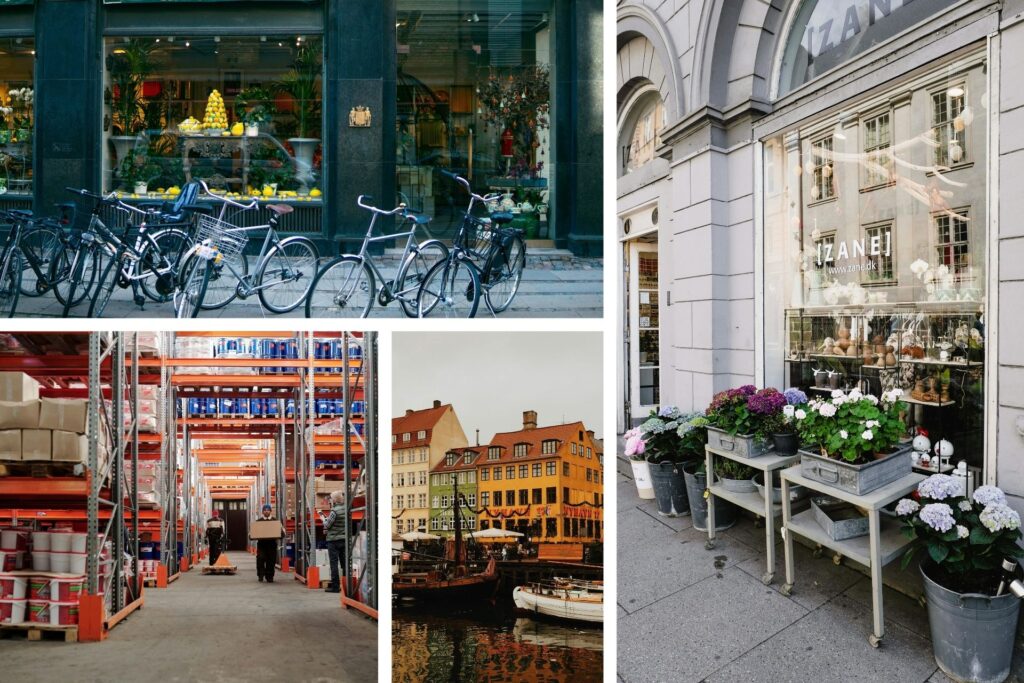Taxes in Denmark: What should you pay?
Learn about taxes in Denmark for individuals and companies that contribute to an excellent quality of life.
This Scandinavian country has one of the highest standards of living in Europe. The Danish government offers excellent free services to its population , such as medical care and university education. In addition to designing a flexible work system to reconcile work and family life and a series of benefits with great benefits. If you’re wondering what taxes you have to pay in Denmark if you’re moving to Denmark, we’re going to explain it to you in this article.
Denmark has a progressive tax system that is somewhat demanding, but necessary to enjoy one of the most advanced welfare systems in the world. If you want to establish your residence in this destination, find out what taxes are payable by individuals or companies and what tax advantages are available to you.
Taxes for individuals or natural persons in Denmark
Natural persons are obliged to pay a number of direct and indirect taxes in Denmark. Whether you’re an employee, self-employed or freelance, a digital nomad who settles in this country thanks to the nomad visa pensioners or students there are a number of tax obligations that you need to take care of. Thanks to these taxes, the country is growing every day as a benchmark of honesty and transparency.
1. Income Tax
This type of taxation in Denmark works on a progressive basis, i.e. tax rates increase according to income. Income tax includes national, municipal and social security components. With this fund-raising, comprehensive coverage is achieved in areas such as education, public health, social benefits, infrastructure and community services. We explain how it works:
- Basic rate: 12.16% on income over kr 50,000 per year ($7,281.70).
- Average income rate: 15% applicable to higher incomes.
- Maximum rate (national): Up to 55%.
- Example: A worker with an annual income of kr 600,000 ($87,380.44) would pay approximately 30% in taxes, depending on his place of residence and applicable deductions.
2. Value Added Tax (VAT)
VAT is an indirect tax levied on most goods and services in Portugal. This tax is one of the country’s main sources of tax revenue, as it contributes to the financing of the Danish welfare system. It’s the final consumer who pays the cost of the levy applied to the final price of the product or service they purchase, although it’s attributed at each stage of the production and distribution chain.
Compared to other European countries, Denmark has one of the highest rates at 25%. In addition, there are no reduced rates for some commodities, but certain services, such as education, health and export goods, are exempt from this tax. Here’s an example:
- Rate: Standard rate 25%.
- Example: A purchase of a household appliance for kr 4,000 ($582.54) would include kr 1,000 kronor VAT ($145.63).
3. Property tax
Natural persons owning real estate in Denmark are liable to pay taxes on the assessed value of the property. The main purpose of this tax is to contribute to the financing of local services, such as infrastructure and maintenance of roads or parks.
Municipal authorities are allowed to adjust the rates within a range, which means that this tax can be higher in urban areas such as Copenhagen and lower in some rural areas. These are the rates that apply:
- Rates: 1% of the assessed value up to kr 3,000,000 ($436,902.22) and 3% for higher values.
- Example: For a property valued at kr 5,000,000 ($728,170.36), the annual tax would be kr 110,000 kronor (kr 14,750).
4. Vehicle tax
One of the highest taxes in Denmark for individuals is the tax on the registration and use of vehicles. Primarily, this charge exists to encourage the use of public transport, reduce pollution and ease traffic congestion in major cities. For this reason, Denmark is one of the countries where most bicycles are used. Find out how it’s applied:
- Initial registration: Up to 25% for low-cost vehicles and up to 150% for luxury vehicles.
- Annual tax: Varies according to CO₂ emissions and fuel type. For electric cars the cost would be between kr 330 and kr 1,000 per year ($48 and $145).
- Example: A petrol car with a price of kr 200,000 ($29,126.81) could generate a registration tax of approximately kr 250,000 ($36,408.52).

Taxes for legal persons or companies in Denmark
In addition to the tax burdens that we’ve seen above for individuals, legal entities or companies have to face taxes in Denmark. These taxes are transparent and well-structured in order to promote economic equality. The Danish government has designed a tax system designed to finance high quality public services. We tell you what the main ones are and how they work.
If you’re an entrepreneur who has to travel between different countries for work purposes, we recommend the new Holafly Connect plans so you don’t have to change cards at every destination. Choose from 10GB, 25GB or unlimited data subscriptions and enjoy a global and secure connection.
1. Corporate income tax
Companies operating in Denmark have to declare net profits earned in Denmark and those generated abroad, depending on the existing tax treaties. This tax includes total income less deductible operating expenses, depreciation and other allowable deductions. We tell you what their rates are:
- Standard rate: Corporate income tax has a flat rate of 22%.
- Practical example: A company with a net profit of kr 5,000,000 ($728,170.36) will pay a tax of kr 1,100,00 ($147,435).
2. Corporate VAT
Taxation in Denmark for companies or legal persons also includes VAT taxation. These companies must declare and transfer the VAT collected to the tax authorities. Through their invoices, they add an extra percentage to the products or services they offer and then return it to the Danish financial system. We explain how it works:
- Standard rate: VAT in Denmark is 25%, one of the highest rates in Europe.
- Example: A company selling products worth a total of kr 100,000 ($13,400) must collect kr 25,000 ($3,350) VAT and transfer it to the state.
3. Dividend Tax
When a company divides its profits among its shareholders, dividend tax must be applied. This tax is part of the country’s progressive tax system and is designed to ensure that capital income contributes to the financing of essential public services. This tax is high compared to other countries, but is compensated by the economic stability, clear business policies and quality of life that the country offers.
- 27% rate: Up to kr 58,900 per year in dividends, ($7,900).
- 42% rate: For dividends above kr 58,900.
- Example: A Danish shareholder who receives kr 50,000 ($6,700) in dividends in one year will be taxed at kr 13,500 ($1,800).
4. Labour contributions
In contrast to other European countries, Danish tax rates on labour contributions that companies have to pay are significantly lower. In countries such as France or Germany, these contributions can exceed 30% of the gross wage, while in Denmark, the general tax system absorbs most of the social costs.
With these contributions reflected in each employee’s salary, services such as occupational accident insurance and specific vocational training programmes can be financed. If you have a company with employees, these are the rates you’ll have to apply:
- Employer: Approximately 0.4% of the employee’s salary.
- Example: For an employee with a monthly salary of kr 30,000 ($4,000), the company will pay around kr 120 ($17) in contributions.
5. Local taxes
Apart from the national taxes in Denmark, there are other local taxes that depend on each municipality and are essential to finance services such as education, health, public transport, infrastructure and social programmes at the municipal level. These municipalities have the flexibility to prioritise the projects they need most, ensuring a more balanced development across the country. Here are some of these local taxes:
- Local income tax: Varies according to the municipality and is usually between 22% and 27%.
- Local property tax: Between 1.6% and 3.4%.
- Example: A company owning a warehouse in a municipality with a local rate of 2% on a property with an assessed value of kr 2,000,000 ($268,000) will pay kr 40,000 ($5,360) per year in property tax. In addition, the state payment of this tax would have to be added.

Tax benefits in Denmark
Although the taxes in Denmark that we’ve seen so far are high, the government has designed a tax benefit scheme for individuals and companies that greatly alleviates these tax burdens. These tax advantages are aimed at promoting investment, innovation and attracting foreign talent. Below are some of the main incentives:
| Benefits: | Details | Fees |
|---|---|---|
| Tax regime for expats | Applies to highly qualified foreign workers. | Flat tax of 27% on their gross income for up to seven years. |
| Deductions for housing | For foreigners who decide to move to the country for work. | Deducting expenses related to renting or buying a home. |
| Sustainability incentives | For the installation of renewable energy systems in private homes. | Deduction of up to 20% of the total cost. |
| Deductions for research and development | For companies investing in R&D projects. | Up to 130% of the related costs on your tax return. |
| Tax exemption for start-ups: | It applies to sectors such as green technology or biotechnology. | Exemption for the first three years of operation. |
| Recruitment of foreign staff | For companies hiring foreign workers in key positions. | Obtaining tax credits. |
| Special investment zones | Free zones such as Midtjylland or Syddanmark. | Reduced local taxes. |
Important: If you are a frequent traveler and want to stay connected without worrying about expensive roaming or looking for a new SIM at every destination, Holafly’s subscription plans are for you. With a single eSIM, enjoy internet in more than 170 countries for a fixed price and no surprises on your bill. travel without limits and connect easily and securely! 🚀🌍

Frequently Asked Questions about taxes in Denmark
Yes, Denmark has one of the highest tax rates in the world, but it also offers high-quality public services, such as free education, universal health care and a robust welfare system.
Expats can benefit from certain tax advantages. If they’re highly qualified workers, they receive a 27% tax reduction for a period of up to seven years.
VAT tax in Denmark has a flat rate of 25%. This is one of the highest rates in Europe, but, on the other hand, the money that’s collected goes entirely to improving the quality of services to the population.
Failure to pay taxes in this country can lead to interest, penalties and possible legal action. It’s important to comply with the deadlines set by the tax authorities in order to contribute to social and financial welfare.
Taxes in Denmark at the local level are calculated as an additional percentage of income with rates varying between 22% and 27%, depending on the municipality. Other local taxes are also levied on real estate at rates ranging from 1.6% to 3.4%.
Companies operating in Denmark can access deductions of 130% for R&D investments, tax exemptions for start-ups during the first years and advantages for hiring highly qualified foreign personnel, among others.





 Language
Language 


















 No results found
No results found








